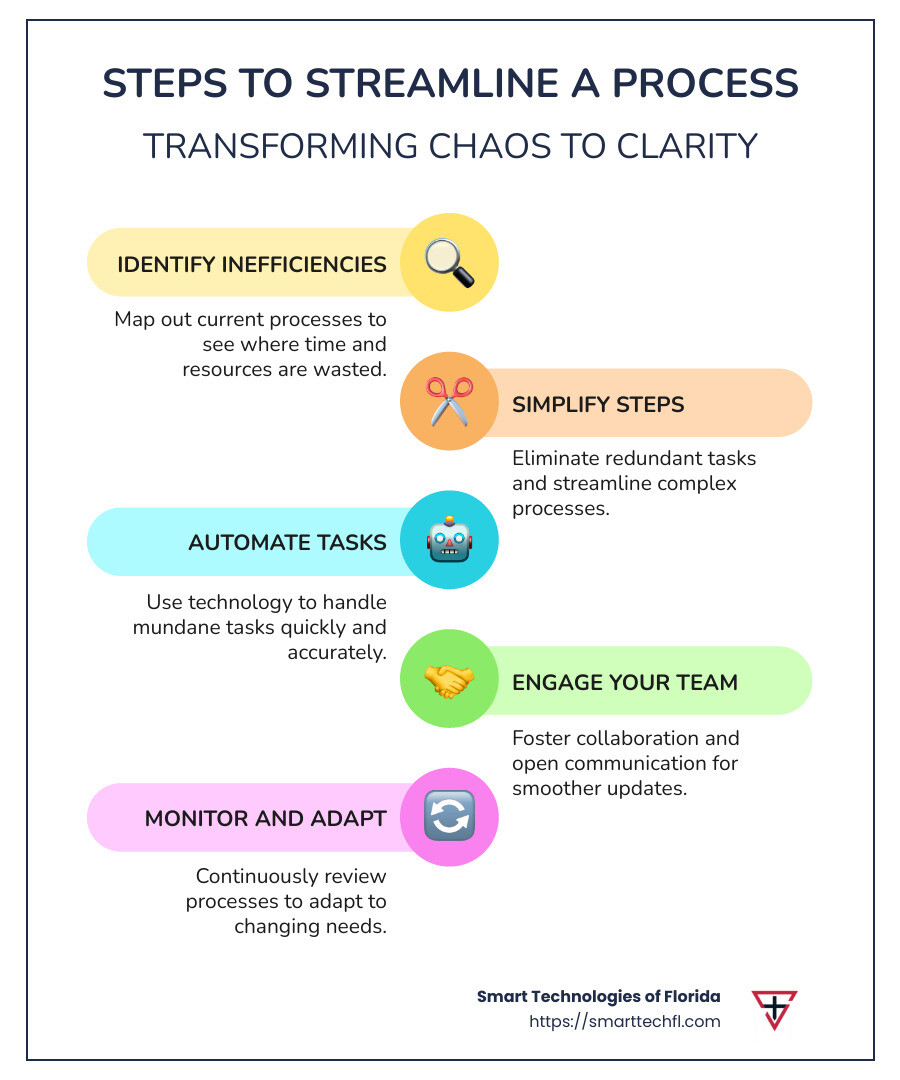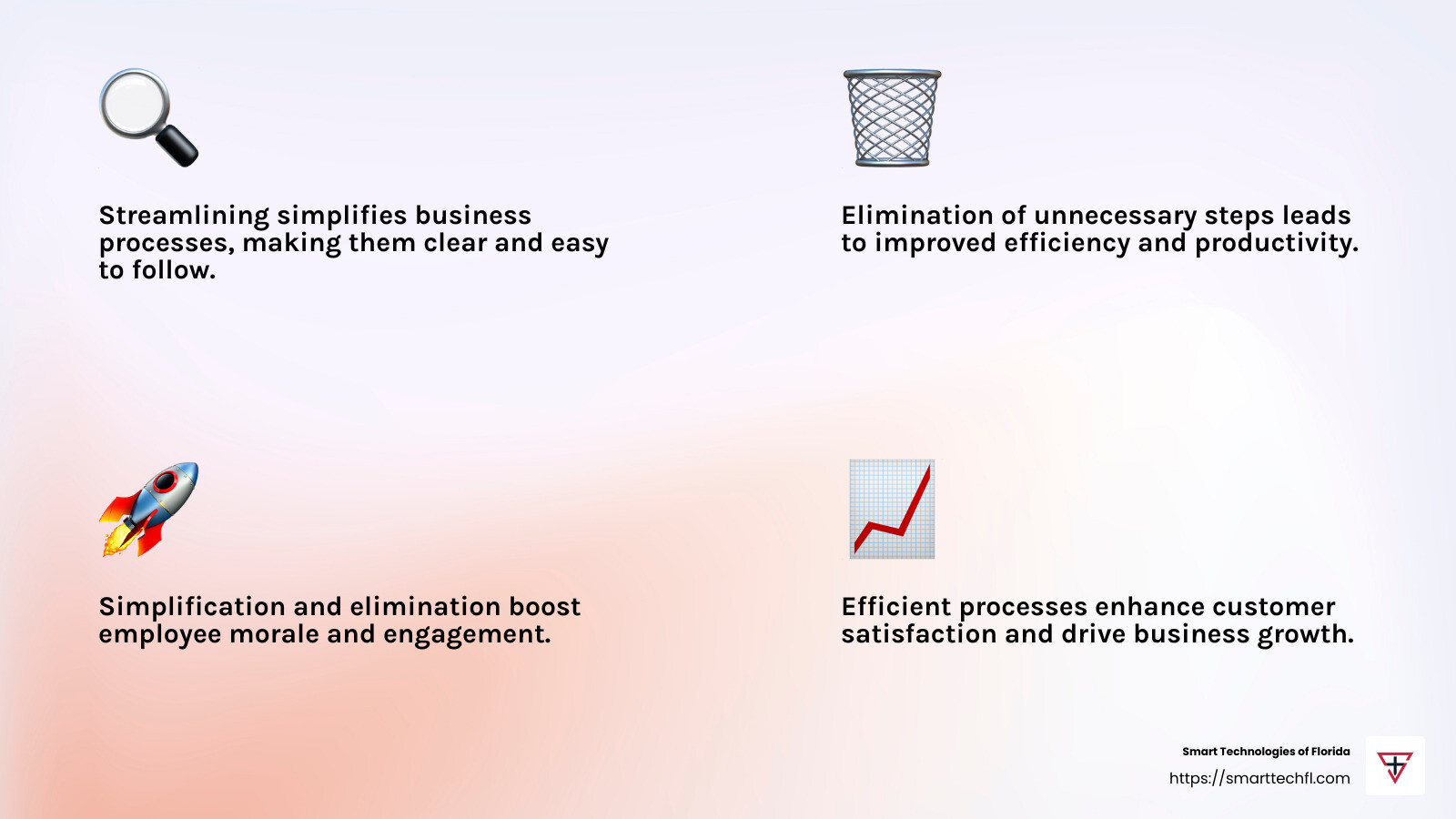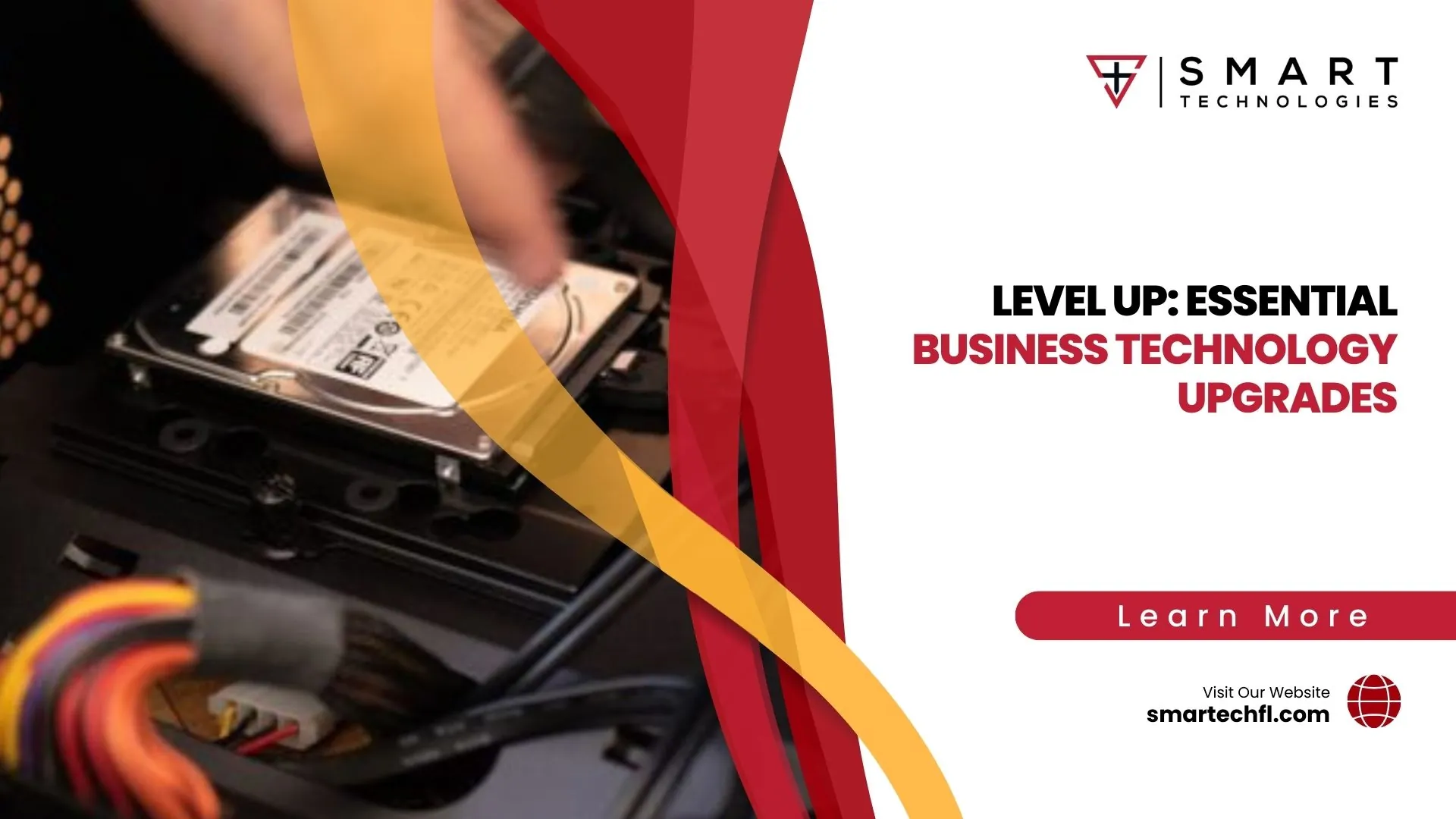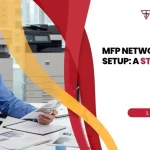From Chaos to Clarity: How to Streamline Your Business Processes
How to streamline business processes effectively can transform your business from chaos to clarity. The secret lies in optimizing your workflows for better efficiency, higher productivity, and operational excellence. Here’s a quick guide to understanding and implementing this change:
- Identify inefficiencies: Map out current processes to see where time and resources are wasted.
- Simplify steps: Eliminate redundant tasks and streamline complex processes.
- Automate repetitive tasks: Use technology to handle mundane tasks quickly and accurately.
- Engage your team: Foster collaboration and open communication for smoother process updates.
- Monitor and adapt: Continuously review processes to adapt to changing needs and improve further.
In our rapidly changing business world, inefficiencies can slow you down. They waste valuable resources and hurt customer satisfaction. The key is to make continuous, small improvements that collectively make a big impact.
Organizing processes boosts consistency and cuts down on delays. It makes work easier and more predictable, allowing your team to focus on delivering exceptional customer experiences.
A notable example comes from the early innovation of Clarence Saunders, who revolutionized the grocery industry by borrowing the self-service concept, reducing staff workload and improving store operations—a bold move that illustrates the power of process innovation.
For a business looking to grow and outperform competitors, streamlining is no longer optional—it’s essential. Smart Technologies of Florida is dedicated to helping you achieve this change, ensuring that your operations are smooth, efficient, and primed for success.

Understanding Process Streamlining
Streamlining a process means making it as simple and efficient as possible. It involves examining every step of a process to find ways to simplify and eliminate unnecessary tasks. This can lead to faster outcomes and fewer problems.
Simplification is all about making things easier. Imagine your current business processes as a tangled ball of yarn. Streamlining is like untangling that yarn, making each thread (or step) clear and easy to follow. When you simplify, you remove the chaos and create order.
For example, the process of invoicing clients can be streamlined by making sure the steps are consistent and repeatable. This means that no matter who is handling the invoicing, the process remains the same, reducing errors and speeding up the workflow.
Elimination is about removing steps that don’t add value. Think of it as decluttering your process. By getting rid of unnecessary tasks, you can focus on what truly matters. For instance, during the onboarding of new employees, filling out paperwork is necessary, but if you find a step that doesn’t contribute to a smooth onboarding experience, it’s time to cut it out.

By focusing on simplification and elimination, businesses can achieve greater efficiency and productivity. This approach not only speeds up processes but also clarifies job duties, which can boost employee morale and engagement. As a result, customer satisfaction improves, and businesses can focus on growth and innovation.
Streamlining is not just about cutting costs; it’s about creating a more agile and responsive organization. This ensures that your business can adapt to changes quickly and continue to deliver exceptional value to customers.
In the next section, we will explore how to streamline a process effectively, focusing on digitization, automation, and addressing bottlenecks.
How to Streamline a Process
When it comes to how to streamline a process, three key strategies come into play: digitization, automation, and tackling bottlenecks. Let’s break these down.
Digitization
Digitization is about changing paper-based processes into digital ones. Imagine replacing stacks of paper with organized digital files that you can access with a click. This not only saves space but also speeds up the retrieval of information.
For example, digitizing the onboarding process allows new hires to complete paperwork online. This reduces the time spent on manual data entry and minimizes errors. It also makes it easier to track progress and ensure compliance with company policies.
Automation
Automation takes digitization a step further by using technology to perform routine tasks. This frees up employees to focus on more strategic activities.
Consider an invoice approval process. Instead of manually routing invoices for approval, automation software can automatically send them to the right people. This reduces delays and ensures timely payments. Plus, it cuts down on human errors, making the process more reliable.
Tackling Bottlenecks
Bottlenecks are points in a process where things slow down or get stuck. Identifying and addressing these is crucial for streamlining.
Start by mapping out your process to see where delays occur. Once identified, you can explore solutions like redistributing tasks, adding resources, or simplifying steps to keep things moving smoothly.
For instance, if customer service requests pile up at a certain point, consider reallocating staff or streamlining the request handling process to improve response times.
By focusing on digitization, automation, and addressing bottlenecks, businesses can create efficient, error-free processes that improve productivity and customer satisfaction.
Next, we’ll dive into the 10 Best Practices for Streamlining Business Processes, exploring how mapping, standardization, and lean principles can further optimize your operations.
10 Best Practices for Streamlining Business Processes
Streamlining business processes is essential for boosting efficiency and cutting down on wasted resources. Here are ten best practices that can help you achieve that:
1. Mapping
Start by mapping out current processes. This means creating a visual representation of each step involved. Think of it as a roadmap that shows the path from start to finish. By doing this, you can easily spot redundancies and areas that need improvement.
Mapping helps everyone understand their roles and responsibilities. It also makes it easier to identify where things might be going wrong, so you can fix them.
2. Standardization
Standardization is about creating uniform procedures for similar tasks. This ensures everyone follows the same steps, which reduces confusion and errors.
For example, if each department handles purchase orders differently, it can lead to delays and mistakes. By standardizing the process, you ensure that everyone is on the same page. This not only speeds things up but also makes training new employees simpler.
3. Lean Principles
Applying lean principles means focusing on eliminating waste. This involves getting rid of any steps in a process that don’t add value.
Lean principles encourage continuous improvement. By regularly reviewing your processes, you can find new ways to cut waste and improve efficiency. This often leads to faster delivery times and higher quality outcomes.
4. Communication
Communication is key to successful streamlining. Make sure everyone involved in a process understands the goals and changes being implemented.
Regular updates and open channels of communication help keep everyone aligned. This reduces resistance to change and encourages collaboration. When everyone knows what’s happening, they’re more likely to work together effectively.
5. Customer Impact
Always consider the customer impact when streamlining processes. The ultimate goal is to improve the customer experience.
For instance, faster response times or more efficient service delivery can greatly improve customer satisfaction. Keep the customer in mind with every change you make to ensure that improvements benefit them as well.
By focusing on mapping, standardization, lean principles, communication, and customer impact, you can streamline your business processes effectively. This not only boosts efficiency but also improves the overall experience for both employees and customers.
Next, we’ll explore various Methodologies for Streamlining, such as lean management and Six Sigma, to further refine your business operations.
Methodologies for Streamlining
Streamlining business processes can be a game-changer for any organization. By adopting proven methodologies, you can improve efficiency and reduce waste. Let’s explore some popular strategies:
Lean Management
Lean management focuses on optimizing resources to create more value with less work. Originating from the Toyota Production System, this approach emphasizes eliminating waste, whether it’s time, resources, or unnecessary steps. The goal is to deliver what the customer needs, when they need it, without overproduction or defects.
Key principles include identifying value, mapping out value streams, and creating a continuous workflow. Lean management is all about finding and removing bottlenecks to maintain a smooth flow of operations.
Six Sigma
Six Sigma aims for near-perfect quality by reducing defects and variability in processes. It uses a data-driven approach to identify the root causes of problems and eliminate them. This methodology is all about precision and accuracy, striving for just 3.4 defects per million opportunities.
The five principles of Six Sigma include prioritizing customer value and promoting stakeholder collaboration. This approach is particularly useful for improving customer retention and meeting high-quality standards.
Business Process Reengineering (BPR)
Business Process Reengineering involves a complete overhaul of core processes to achieve significant improvements. Unlike other methods that tweak existing processes, BPR looks at the bigger picture. It’s about redesigning from scratch to improve quality, speed, and profitability.
This approach is ideal for organizations facing widespread inefficiencies or outdated processes. By rethinking operations, businesses can achieve breakthroughs in performance.
Total Quality Management (TQM)
Total Quality Management is a continuous, organization-wide effort to improve quality and performance. It emphasizes total employee involvement and focuses on customer satisfaction. TQM uses data and effective communication to drive improvements across all areas of an organization.
The eight principles of TQM include customer focus, continuous improvement, and data-based decision-making. This holistic approach ensures that quality is ingrained in every aspect of the business.
Agile
Agile is a flexible project management methodology that breaks down tasks into smaller, manageable sprints. Teams reflect on their performance at the end of each sprint and adapt as needed. This iterative process encourages continuous improvement and quick adaptation to changes.
Agile prioritizes collaboration, both within teams and with customers. It’s about delivering effective outcomes and being responsive to change, making it ideal for dynamic business environments.
Kaizen
Kaizen is a Japanese term meaning “continuous improvement.” It focuses on small, incremental changes that collectively lead to significant improvements. This approach encourages every employee to suggest ideas for enhancing processes.
Kaizen fosters a culture of ongoing improvement, where everyone is engaged in finding better ways to work. It’s about making small tweaks that add up to big results over time.
Theory of Constraints
The Theory of Constraints identifies the most significant limiting factor in a process and works to improve it. The idea is that every system has a bottleneck that restricts overall performance. By addressing this constraint, you can dramatically improve the entire process.
This methodology involves five steps: identify the constraint, exploit it, subordinate other processes to it, lift it, and repeat the process.
Business Process Management (BPM)
Business Process Management is a systematic approach to making an organization’s processes more effective and efficient. It involves modeling, analyzing, and optimizing processes to achieve better outcomes.
BPM software can help automate and monitor processes, providing real-time insights and enabling continuous improvement. This approach ensures that processes are aligned with business goals and can adapt to changes swiftly.
By understanding and implementing these methodologies, you can transform chaotic processes into streamlined operations. Up next, we’ll explore the Technologies to Streamline Business Processes that can further improve your efficiency.
Technologies to Streamline Business Processes
Streamlining business processes often involves leveraging technology to simplify and automate tasks. Here’s how different types of software can help:
BPM Software
Business Process Management (BPM) software is like the conductor of an orchestra, ensuring that every part of the business process plays its role at the right time. It helps map out processes, automate repetitive tasks, and monitor performance. With BPM software, you can visualize workflows, identify bottlenecks, and make data-driven decisions to improve efficiency. It’s particularly useful for organizations that need to keep complex processes running smoothly.
CRM Software
Customer Relationship Management (CRM) software focuses on enhancing interactions with customers. It helps businesses organize customer data, track interactions, and improve customer service. By automating routine tasks like follow-ups and lead scoring, CRM software frees up your team to focus on building relationships. This can lead to better customer retention and increased sales.
ECM Software
Enterprise Content Management (ECM) software is all about managing and delivering content across an organization. It integrates with BPM and CRM systems to ensure that the right information is available at the right time. ECM software helps store, manage, and retrieve documents efficiently, reducing the time spent searching for information and increasing productivity. It’s particularly beneficial for businesses dealing with large volumes of documents and data.
Project Management Software
Project Management Software helps break down large projects into smaller, manageable tasks. It organizes tasks, assigns them to team members, and tracks progress. These tools often include features like Gantt charts, task lists, and collaboration spaces, making it easier for teams to work together. By keeping everyone on the same page, project management software ensures that projects are completed on time and within budget.
Personal Productivity Tools
Personal Productivity Tools are designed to help individuals manage their time and tasks more effectively. These tools can include to-do lists, calendar apps, and time-tracking software. By automating mundane tasks and providing reminders, they help employees focus on high-priority work. This leads to increased productivity and less stress.
Incorporating these technologies can transform chaotic business processes into streamlined operations, making your organization more agile and efficient. Up next, we’ll tackle some Frequently Asked Questions about Streamlining Processes to address common concerns and misconceptions.
Frequently Asked Questions about Streamlining Processes
What does it mean to streamline a process?
Streamlining a process means making it more efficient and effective. It’s about simplifying tasks and eliminating unnecessary steps. This leads to faster outcomes and fewer errors. By removing clutter and focusing on what truly matters, businesses can achieve their goals more quickly and with less effort. Streamlining isn’t just about cutting steps; it’s about refining them to work better together.
What should you do to streamline the process?
To streamline a process, start with digitization and automation. Digitization involves converting paper-based processes into digital formats, making it easier to store, access, and share information. Automation takes it a step further by using technology to perform repetitive tasks automatically. This reduces human error and frees up time for more strategic work.
Think of it like this: instead of manually entering data into spreadsheets, use software to automatically capture and organize that data. This not only saves time but also ensures accuracy.
What is the method of streamlining?
The method of streamlining focuses on creating processes with minimum friction. This means designing workflows that are smooth and seamless, without unnecessary problems. The goal is to make it easy for tasks to flow from start to finish without interruptions.
Design plays a crucial role here. Well-designed processes consider the user experience, ensuring that each step is intuitive and logical. By aligning processes with the way people naturally work, businesses can improve both efficiency and employee satisfaction.
Streamlining is about making processes as straightforward as possible, so your team can focus on what truly matters—delivering value to your customers.
Conclusion
At Smart Technologies of Florida, we believe that strategic change and innovation are the keys to changing business processes from chaos to clarity. Our 23 years of experience have taught us that a people-centric approach is essential for empowering businesses to achieve their unique goals.
Streamlining isn’t just a buzzword—it’s a strategic necessity. By embracing digitization and automation, businesses can eliminate bottlenecks and improve efficiency. This change allows teams to focus on what truly matters: delivering exceptional value to customers.
Our custom digital solutions are designed to align with your business’s specific needs. We understand that each organization is unique, and our approach ensures that your processes are not just streamlined but optimized for success.
Whether it’s through business process management, lean principles, or other methodologies, we are committed to helping you steer the journey from chaos to clarity. Our goal is to simplify complexity and drive innovation, ensuring your business remains agile and competitive.
Ready to transform your processes and boost productivity? Explore our Business Processes Automation services and find how we can help you achieve operational excellence.
Let’s turn challenges into opportunities and set your business on the path to sustainable success.












